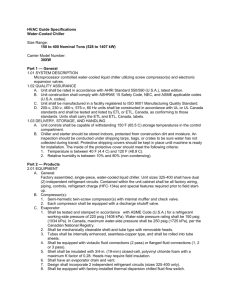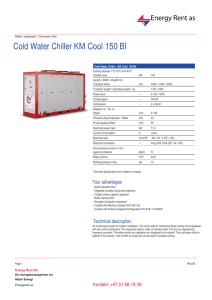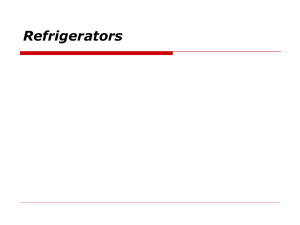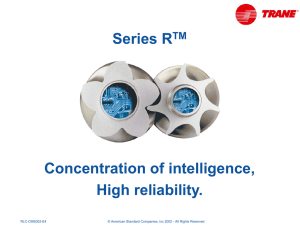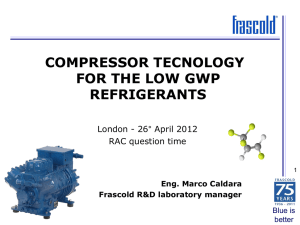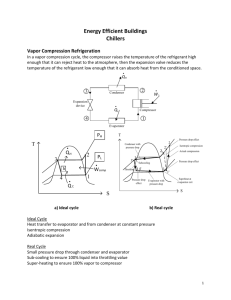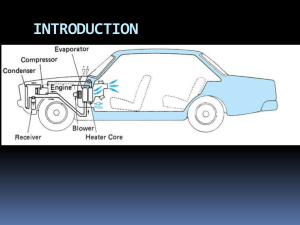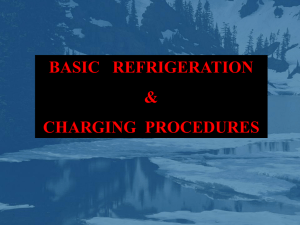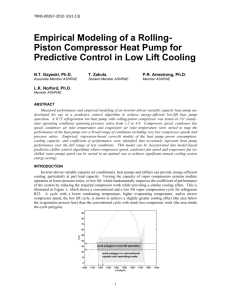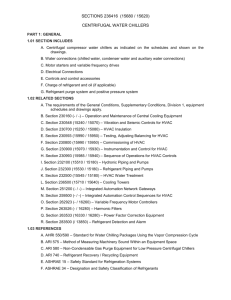IBO-Presentationversion
advertisement
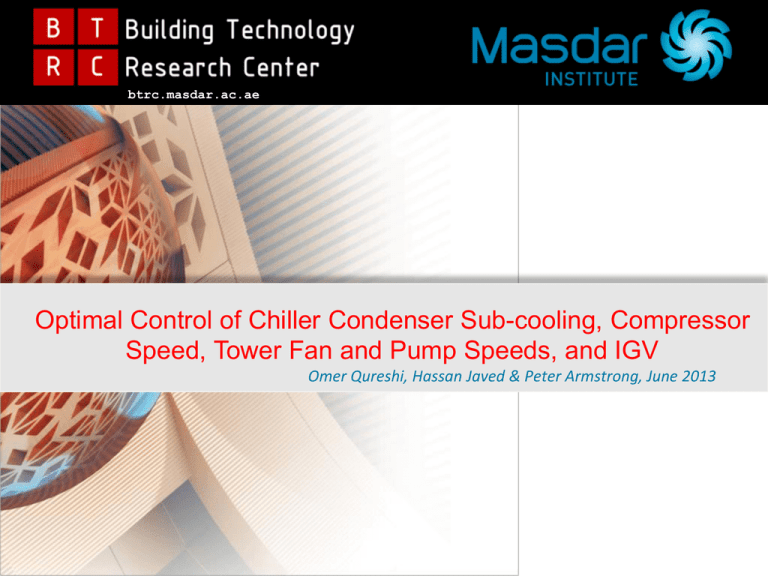
btrc.masdar.ac.ae Optimal Control of Chiller Condenser Sub-cooling, Compressor Speed, Tower Fan and Pump Speeds, and IGV Omer Qureshi, Hassan Javed & Peter Armstrong, June 2013 1 Presentation Outline Introduction SCADA and Heat Balance Analysis Component Models Chiller System Solver Optimization Conclusion and Future Work 2 Introduction Plant under consideration-(4x2500T). Collection and analysis SCADA Development of sub models for Individual chiller components Validation of model Development of solver- to execute these sub models and predict chiller performance. Optimize the model to produce set of conditions for optimum power consumption. 3 District Cooling Plant Selected District cool Plant Capacity (4x2500T) Shell and tube Evaporator and Condenser Constant speed single stage centrifugal compressor Capacity control by Pre-rotation vanes Surge control Variable geometry diffuser 2-cell cooling tower each with variable speed fan (Fan diameter: 8m) Variable speed chilled water pump Constant speed condenser water pump 4 Chiller Unit 1. Maintenance manual of York Chiller(Source: Tabreed) 5 SCADA & Heat Balance Analysis 6 Components Models—Chiller Unit Steady-state models based on first principle Inputs Component engineering parameters SCADA Data Simple models, less computation time Four Component models for district cooling plant Evaporator Model----Shell and tube Condenser Model----Shell and tube Centrifugal Compressor Model (Isentropic work + loss Mechanism) • Constant speed • Variable speed Variable speed pump model 7 Evaporator Model ENGINEERING PARAMETERS Tubes Length of shell Copper 6.6 m Tube Pass (water) 2 Total no. of tubes 1234 Tube Diameter 0.75" or 1.905x10-2 m Tube thickness 0.028" or 7.11x10-4 m Assumptions: No pressure drop considered for refrigerant side Thermal resistance from refrigerant side is neglected. 8 Evaporator Model 𝑸𝒕,𝒆 𝑯𝒍𝒊𝒒,𝒂𝒔 𝑽𝒆 𝑻𝒘,𝒊𝒏,𝒄 𝒅𝑻𝒆𝒔𝒉 𝒎𝒓 Evaporator 𝑇𝑤,𝑜𝑢𝑡,1 Evaporation 𝑇𝑤,𝑜𝑢𝑡,2𝑎 Evaporation 𝑇𝑤,𝑜𝑢𝑡,2𝑏 𝑻𝒆 𝑻𝒘,𝒐𝒖𝒕,𝒆 Superheating 𝑷𝑬𝒏𝒈𝒈. 1st Pass 2nd Pass Two regions for refrigerant were modeled: Evaporation Superheating 𝞮 – NTU Method Single Stream HX for evaporation Crossflow HX for super heating 9 Evaporator Model Equations utilized in Evaporator Model 𝑇𝑤,𝑜𝑢𝑡,𝑒 = 𝑇𝑤,𝑖𝑛,𝑒 − ℎ𝑖𝑛,𝑒 = 0.023 𝑅𝑒𝑒 0.8 𝑃𝑟0.4 𝑘𝑤 𝑄𝑡,𝑒 𝑐𝑝,𝑤 𝑚𝑤 𝑈𝐴𝑒 = 𝐷𝑒,𝑖 𝐶𝑚𝑖𝑛 = 1 1 𝐴𝑖𝑛,𝑒 ℎ𝑖𝑛,𝑒 + 𝑅𝑃,𝑒 min[𝑐𝑝,𝑤 𝑚𝑤,𝑒 , 𝐶𝑝,𝑟 𝑚𝑟 ] 𝐴𝑖𝑛,𝑒,1 = 𝜋 𝐷𝑒,𝑖 𝐿𝑒 (𝑁𝑒 /2) 𝐴𝑖𝑛,𝑒,1𝑎 = 𝜋 𝐷𝑒,𝑖 𝑥𝑒 𝐿𝑒 (𝑁𝑒 /2) 𝐴𝑖𝑛,𝑒,1𝑏 = 𝜋 𝐷𝑒,𝑖 (1 − 𝑥𝑒 ) 𝐿𝑒 (𝑁𝑒 /2) Evaporation Evaporation Superheating 10 Evaporator Model Equations utilized in Evaporator Model Equation for regressed length: 𝐿𝑒 = 8.947𝑥10−3 𝑚𝑟2 − 3.6279𝑥10−1 𝑚𝑟 + 7.227 Equation for temperatures: 𝑇𝑤,𝑜𝑢𝑡,1 = 𝑇𝑤,𝑖𝑛,𝑒 − (𝑇𝑤,𝑖𝑛,𝑒 − 𝑇𝑒 ) 1 − 𝑒 −𝑁𝑇𝑈𝑒1 𝑇𝑤,𝑜𝑢𝑡,2𝑎 = 𝑇𝑤,𝑜𝑢𝑡,1 − (𝑇𝑤,𝑜𝑢𝑡,1 − 𝑇𝑒 ) 1 − 𝑒 −𝑁𝑇𝑈𝑒,2𝑎 𝑇𝑤,𝑜𝑢𝑡,2𝑏 = 𝑇𝑤,𝑜𝑢𝑡,2𝑎 − 𝜀2𝑏 (𝑇𝑤,𝑜𝑢𝑡,2𝑎 − 𝑇𝑒 ) 𝜀2𝑏 = 1 − 𝑒𝑥𝑝 1 𝐶𝑟 𝑁𝑇𝑈𝑒2𝑏 0.22 exp −𝐶𝑟 𝑁𝑇𝑈𝑒,2𝑏 0.78 −1 11 Evaporator Model 1. Maintenance manual of York Chiller(Source: Tabreed) 12 Evaporator Model 4 0.2096 C NRMS 0.0319 3.5 Modeled Te (C) RMS Measured Te (C) vs Modeled Te (C) Measured Te (C) 15% error line -15% error line 3 2.5 2 1.5 1.5 2 2.5 3 Measured Te (C) 3.5 4 13 Condenser Model ENGINEERING PARAMETERS Tubes Length of shell Tube Pass (water) Total no. of tubes Sub-cooling Section: Tube Diameter No. of tubes Tube thickness Tube Surface Area Condensation & de-superheating Section: Tube Diameter No. of tubes Tube thickness Tube Surface Area Copper 6.6 m 2 937 0.75" or 1.905x10-2 m 180 0.028" or 7.11x10-4 m 66.78 m2 1" or 2.54x10-2 m 757 0.035" or 8.89x10-4 m 376.44 m2 Assumptions: No pressure drop considered for refrigerant side Thermal resistance from refrigerant side is neglected. 14 Condenser Model 𝒎𝒓 𝑻𝒄 𝑽𝒄 Condenser 𝑻𝒘,𝒊𝒏,𝒄 𝑻𝒄𝒐𝒎𝒑,𝒐𝒖𝒕 𝑷𝑬𝒏𝒈𝒈. 𝑻𝒘,𝒐𝒖𝒕,𝒄 𝑇𝑤,𝑚𝑖𝑥,𝑐 Condensation 𝑇𝑤,𝑜𝑢𝑡,2𝑎 Condensation 𝑇𝑤,𝑜𝑢𝑡,2𝑏 Desuperheating 𝑸𝒄 𝑯𝒍𝒊𝒒 Sub-cooling 1st Pass 2nd Pass Three regions for refrigerant were modeled: Sub-cooling Condensation De-Superheating 𝞮 – NTU Method 15 Condenser Model Equations utilized in Condenser Model 1a. Sub-Cooling Section(First Pass): ℎ𝑖𝑛,𝑐,1𝑎 = 0.023 𝑅𝑒𝑐1 0.8 𝑃𝑟 0.4 𝑈𝐴𝑐,1𝑎 = 1 1 𝐴𝑖𝑛,𝑐,1𝑎 ℎ𝑖𝑛,𝑐,1𝑎 + 𝑅𝑃,𝑐,1𝑎 𝑇𝑐𝑠 = 𝑇𝑐2 − 𝑇𝑤,𝑜𝑢𝑡,1𝑎 𝜀𝑐,1𝑎 = 𝑘𝑤 𝐷𝑐1,𝑖 1 − 𝑒 −𝑁𝑇𝑈𝑐,1𝑎 1−𝐶𝑟,1𝑎 1 − 𝐶𝑟,1𝑎 𝑒 −𝑁𝑇𝑈𝑐,1𝑎 (1−𝐶𝑟,1𝑎) 𝜀𝑐,1𝑎 𝐶𝑚𝑖𝑛,1𝑎 (𝑇𝐶2 − 𝑇𝑤,𝑖𝑛,𝑐 ) 𝑚𝑟 𝑐𝑝,𝑟 𝑚𝑟 𝑐𝑝,𝑟 (𝑇𝐶2 − 𝑇𝑆𝐶 ) = 𝑇𝑤,𝑖𝑛,𝑐 + 𝑚𝑤,𝑐 𝑥1,𝑎 𝑐𝑝,𝑤 16 Condenser Model 1b. Condensation Section (First Pass): ℎ𝑖𝑛,𝑐,1𝑏 = 0.023 𝑅𝑒𝑐1𝑏 0.8 𝑃𝑟 0.4 𝑈𝐴𝑐,1𝑏 = 1 1 𝐴𝑖𝑛,𝑐,1𝑏 ℎ𝑖𝑛,𝑐,1𝑏 + 𝑅𝑃,𝑐,1𝑏 𝑇𝑤,𝑜𝑢𝑡,1𝑏 𝑘𝑤 𝐷𝑐2,𝑖 𝑁𝑇𝑈𝑐,1𝑏 = 𝑈𝐴𝑐,1𝑏 𝐶𝑚𝑖𝑛,𝑤 𝑥𝑐𝑎 𝑚𝑟 (𝐻𝐶2 − 𝐻𝐶3 ) = 𝑇𝑤,𝑖𝑛,𝑐 + 𝑚𝑤,𝑐 (1 − 𝑥1𝑎 )𝑐𝑝,𝑤 Mixing Section: 𝑇𝑤,𝑚𝑖𝑥,𝑐 = 𝑚𝑤,𝑐 𝑥1,𝑎 𝑇𝑤,𝑜𝑢𝑡1,𝑎 − 𝑚𝑤,𝑐 (1 − 𝑥1𝑎 ) 𝑇𝑤,𝑜𝑢𝑡1𝑏 𝑚𝑤,𝑐 17 Condenser Model 2a. Condensation Section (Second Pass): ℎ𝑖𝑛,𝑐,2𝑎 = 0.023 𝑅𝑒𝑐2𝑎 0.8 𝑃𝑟 0.4 𝑈𝐴𝑐,2𝑎 = 1 1 𝐴𝑖𝑛,𝑐,2𝑎 ℎ𝑖𝑛,𝑐,2𝑎 + 𝑅𝑃,𝑐,2𝑎 𝑇𝑤,𝑜𝑢𝑡,2𝑎 = 𝑇𝑤,𝑚𝑖𝑥,𝑐 + 𝑘𝑤 𝐷𝑐2,𝑖 𝑁𝑇𝑈𝑐,2𝑎 = 𝑈𝐴𝑐,2𝑎 𝐶𝑚𝑖𝑛,𝑤 𝑥𝑐𝑏 𝑚𝑟 𝑐𝑝,𝑟 (𝐻𝐶2 − 𝐻𝐶3 ) 𝑚𝑤,𝑐 𝑐𝑝,𝑤 2b. De-superheating Section (Second Pass): 𝑇𝑤,𝑜𝑢𝑡,2𝑏 = 𝑇𝑤,𝑜𝑢𝑡2𝑎 + 𝑚𝑟 𝑐𝑝,𝑟,2𝑏 (𝑇𝐶1 − 𝑇𝐶2 ) 𝑚𝑤,𝑐 𝑐𝑝,𝑤 18 Condenser Model 0.0949 C NRMS 0.0225 Measured Tc (C) vs Modeled Tc (C) Measured Tc (C) 2.5% error line -2.5% error line 32 30 Modeled Tc (C) RMS 34 28 26 24 22 22 24 26 28 30 Measured Tc (C) 32 34 19 Condenser Model 35 0.6481 C NRMS 0.1471 30 Modeled Tw,out (C) RMS Measured Tw,out (C) vs Modeled Tw,out (C) Measured Tw,out (C) 5% error line -5% error line 25 20 20 25 30 35 Measured Tw.out (C) 20 Compressor Model Integral and mathematically most complex part of chiller Constant and variable speed compressor model Non-Dimensional loss model based on Aungier(2000) Assumptions Centrifugal Compressor Specification • Gear efficiency is taken as 90% Refrigerant • Velocity profile is assumed as constant, along the hub and tip Rating (Btuh) 2500 • The kinetic energy of refrigerant entering the diffuser is completely converted to useful energy Rating (kW input) 1817 Rating discharge pressure (psig) 162 • Diffuser and IGV losses are not modeled Rating suction pressure psig) 34 • Water flow rate for motor cooling is taken as constant • Complex engineering parameters in impeller geometry Rating suction temperature (F) R134A 33/34 Impeller diameter (outlet diameter) m 0.7 Impeller hub diameter (inlet diameter) 0.3 Impeller Blade Angle (degree) 45/50 21 Compressor Model-Inputs and Outputs Constant Speed Model Input IGV Positions Constant RPM Inlet and outlet pressure of compressor Inlet and outlet blade and velocity angles of impeller Impeller Inlet and outlet engineering parameters and dimensions Gear efficiency Output Compressor Power Pressure at impeller exit Temperature at compressor outlet Pressure drop due to Impeller losses Variable speed Model Input Mass flow rate of refrigerant Inlet and outlet pressure of compressor Inlet and outlet blade and velocity angles of impeller Impeller Inlet and outlet engineering parameters and dimensions Gear efficiency Output Compressor Power Compressor RPM Pressure at impeller exit Temperature at compressor outlet Pressure drop due to Impeller losses 22 Validation Constant Speed Compressor Model 1600 Actual Power(kW) Model Power(kW) Loss Power(kW) Model Comp Power(kW) 1400 Copmressor Power (KW) 1200 1000 800 600 400 200 0 0 200 400 600 800 No. of Observations 1000 1200 1400 23 Validation Constant Speed Compressor Model 1600 108.34 KW NRMS 0.1553 1400 1200 Model Power(kW) RMS Measured Power(kW) vs Model Power(kW) Measured Power(kW) 10% Error line -10% Error line 1000 800 600 400 400 600 800 1000 1200 Measured Power(kW) 1400 1600 24 Variable Speed Compressor Model 𝐼𝑠𝑒𝑛𝑡𝑟𝑜𝑝𝑖𝑐 𝑊𝑜𝑟𝑘 = 𝑤𝑖𝑠𝑒𝑛 𝑃1 = − 1 𝜌1 −1 𝑃3 𝑃1 −1 𝜂𝑔𝑒𝑎𝑟 𝑀𝑎𝑠𝑠 𝐹𝑙𝑜𝑤 𝑟𝑎𝑡𝑒 𝑜𝑓 𝑟𝑒𝑓𝑟𝑖𝑔𝑒𝑟𝑎𝑛𝑡 = 𝑚 = 𝜙2 𝐴2 𝑈2 𝜌2 RPM is calculated in an iterative process by satisfying the following equation 𝑟𝑒𝑠𝑢𝑙𝑡 = 𝑚𝑠𝑐𝑎𝑑𝑎 − 𝑚𝑐𝑎𝑙 Total Work 𝑊𝑎𝑐𝑡 = 𝑊𝑐𝑜𝑚𝑝 + 𝑊𝑙𝑜𝑠𝑠 Loss Model Calculations 𝑊𝑙𝑜𝑠𝑠 = ∆𝑃𝑡𝑟 𝑉𝑟 Total Relative Pressure Drop (Due to Losses) 𝑖 ∆𝑃𝑡𝑟 = 𝑓𝑐 (𝑃𝑡𝑟 1 − 𝑃𝑠1 ) 𝑖 25 Variable Speed Compressor Model-Benefits/comparison Compressor Power (KW) Variable Speed Compressor (KW) Measured Compressor Power (KW) Power (KW) IGV Position 1504.702 44.2 Operation Conditions: 1. mr (kg/s) 2. Pout/Pin No. of Observations 26 Impeller Loss Model 𝑉𝑚 1 𝐼𝑛𝑐𝑖𝑑𝑒𝑛𝑐𝑒 𝐿𝑜𝑠𝑠 = 1 − 𝑊1 sin(𝑚 1 ) 𝑊1𝑇ℎ 𝐷𝑖𝑓𝑓𝑢𝑠𝑖𝑜𝑛 𝑙𝑜𝑠𝑠 = 0.8 1 − 𝑊1 2 𝑡𝑏1 𝑍 + 2𝑟𝑚 1 sin(𝑚 1 ) 2 2 − 𝐼𝑛𝑐𝑖𝑑𝑒𝑛𝑐𝑒 𝐿𝑜𝑠𝑠 𝑆𝑘𝑖𝑛 𝐹𝑟𝑖𝑐𝑡𝑖𝑜𝑛 𝐿𝑜𝑠𝑠 = 4𝑐𝑓 𝑊 𝑊1 2 𝐿𝐵 𝐷𝐻 (∆𝑊 𝑊1 )2 𝐵𝑙𝑎𝑑𝑒 𝐿𝑜𝑎𝑑𝑖𝑛𝑔 𝐿𝑜𝑠𝑠 = 24 ( − 1)𝑉𝑚 2 𝐸𝑥𝑝𝑎𝑛𝑠𝑖𝑜𝑛 𝐿𝑜𝑠𝑠 = 𝑊1 𝐶𝑙𝑒𝑎𝑟𝑎𝑛𝑐𝑒 𝐺𝑎𝑝 𝐿𝑜𝑠𝑠 = 2 2𝑚𝐶𝐿 ∆𝑃𝐶𝐿 𝑚 1 𝑊12 2 (𝑚 𝑏 𝑊 𝑊1 ) 𝐻𝑢𝑏 − 𝑆ℎ𝑟𝑜𝑢𝑑 𝐿𝑜𝑠𝑠 = 6 27 Variable Speed Compressor Model-losses profile 120 Pressure Drop (kPa) 100 80 Clearance gap loss (kPa) Diffusion loss (kPa) Hub-shroud Loss (kPa) Incident loss (kPa) Skin friction loss (kPa) Blade Loading Loss (kPa) Expansion Loss (kPa) 60 40 20 0 20 25 30 35 Refrigerant Mass Flow (kg/s) 40 45 50 28 Cooling Tower Model Effectiveness NTU Method 𝐻𝑒𝑎𝑡 𝑅𝑒𝑗𝑒𝑐𝑡𝑒𝑑 = 𝑄𝑟𝑒𝑗𝑒𝑐𝑡𝑒𝑑 = 𝑚𝑤 ∗ 𝑐𝑝𝑤 ∗ (𝑇𝑐𝑤𝑠 − 𝑇𝑐𝑤𝑟) 𝐶𝑜𝑜𝑙𝑖𝑛𝑔 𝑇𝑜𝑤𝑒𝑟 𝑅𝑒𝑡𝑢𝑟𝑛 𝑇𝑒𝑚𝑝𝑒𝑟𝑎𝑡𝑢𝑟𝑒 = 𝑇𝑐𝑤𝑠 − 𝑄𝑟𝑒𝑗𝑒𝑐𝑡𝑒𝑑 𝑚𝑤 ∗ 𝑐𝑝𝑤 𝑄𝑟𝑒𝑗𝑒𝑐𝑡𝑒𝑑 = ∗ 𝐶𝑚𝑖𝑛 ∗ (𝑇𝑐𝑤𝑠 − 𝑇𝑤𝑏 ) 1 − 𝑒 −𝑁𝑇𝑈(1−) = 1 − 𝑒 −𝑁𝑇𝑈(1−) 𝑁𝑇𝑈 = 𝑚_𝑤 𝑀𝑒𝑀 𝑚_𝑎 𝐾 ∗ 𝑎 ∗ 𝑉 𝑀𝑒𝑀 = 𝑚_𝑤 Regression Coefficient 𝑀𝑎𝑠𝑠 𝐹𝑙𝑜𝑤 𝑜𝑓 𝐴𝑖𝑟 = 𝑚_𝑎 = 𝑉𝑚𝑎𝑥 ∗ 𝜌𝑎 ∗ 𝑓 29 Cooling Tower Model Assumptions, Specifications and Input/ Output Variables Assumptions • • Cooling Tower Specifications Air exiting the tower is saturated with water Rating (RT) 5000 vapor and is only characterized by its Rating flow rate (GPM) 15300 enthalpy Rating ambient wet bulb (F) 86 Rating ambient dry bulb (F) 122 Rating entering condenser water 105 Reduction of water flow rate by evaporation is neglected in the energy balance. • Mass flow rate is calculated by considering linear proportionality of mass flow rate of air and motor speed. temperature (F) Fan diameter and speed (m, RPM) 8/152.6 Air flow rate (CFM) 776383 Inputs • • • • • Wet-bulb temperature Cooling tower supply water temperature Dry-bulb temperature Mass flow rate of water Cooling tower fan/motor speed Outputs • • Cooling tower return water temperature Merkel’s Number 30 Cooling Tower Model 31 Pump Model Mainly there are two mode of operation for these pumps: Constant flow pump Variable flow pump with a variable speed drive To model a variable pump power following relationship is used: 𝑃𝑝𝑜𝑤𝑒𝑟 = 𝑃𝑀𝑃(𝐶1 + 𝑃𝐿𝑅(𝐶2 ) + 𝑃𝐿𝑅(𝐶3 )2 +𝑃𝐿𝑅(𝐶4 )3 ) Where, PMP = pump motor power at rated condition, kW C1, C2, C3 and C4 are pump performance coefficients Also, PLRi = pump part load ratio defined as follows: 𝑤𝑎𝑡𝑒𝑟 𝑓𝑙𝑜𝑤 𝑟𝑎𝑡𝑒 𝑉𝑖 𝐺𝑃𝑀 𝑃𝐿𝑅𝑖 = = 𝑝𝑢𝑚𝑝 𝑐𝑎𝑝𝑎𝑐𝑖𝑡𝑦 𝑉𝑅 𝐺𝑃𝑀 32 Pump Model Validation Graph + 5%Error Line 33 Solver Description Qt,e Tw,in,e Tw,in,c Ve Vc dTsh,e 34 Optimization Optimization performed with two configurations: Chiller Water Flow Optimization Chiller Water Flow And Condenser Water Flow Optimization Objective Function: Minimize total power consumption i.e. compressor power and pump(s) power combined. 35 Optimization Chiller Water Flow Optimization: Tw,in,c = 25 C and Tw,in,e = 14 C Vc Qe 0.4795 m3/s 10000 KW Power Ve Total (KW) (m3/s) 2791.90 2494.66 2325.43 2226.70 2171.34 2145.79 2149.01 2177.04 2227.85 2300.43 2389.48 0.1419 0.1774 0.2129 0.2484 0.2839 0.3194 0.3548 0.3903 0.4258 0.4613 0.4968 COP 3.58 4.01 4.30 4.49 4.61 4.66 4.65 4.59 4.49 4.35 4.19 Vc Qe 0.4795 m3/s 8000 KW Power Ve Total (KW) (m3/s) 1768.81 1617.53 1535.14 1492.30 1476.36 1483.94 1512.07 1559.59 1623.07 1708.17 1809.82 0.1419 0.1774 0.2129 0.2484 0.2839 0.3194 0.3548 0.3903 0.4258 0.4613 0.4968 COP 4.52 4.95 5.21 5.36 5.42 5.39 5.29 5.13 4.93 4.68 4.42 Vc Qe 0.4795 m3/s 6000 KW Power Ve Total (KW) (m3/s) 1102.50 1032.45 997.69 988.83 998.06 1023.13 1065.53 1122.92 1197.94 1288.91 1397.89 0.1419 0.1774 0.2129 0.2484 0.2839 0.3194 0.3548 0.3903 0.4258 0.4613 0.4968 COP 5.44 5.81 6.01 6.07 6.01 5.86 5.63 5.34 5.01 4.66 4.29 Vc Qe 0.4795 m3/s 4000 KW Power Ve Total (KW) (m3/s) 649.15 626.16 622.12 633.21 657.75 695.26 746.65 811.97 892.40 988.98 1103.05 0.1419 0.1774 0.2129 0.2484 0.2839 0.3194 0.3548 0.3903 0.4258 0.4613 0.4968 COP 6.16 6.39 6.43 6.32 6.08 5.75 5.36 4.93 4.48 4.04 3.63 36 Optimization Total Power (KW) Chiller Water Flow And Condenser Water Flow Optimization: Qe Ve,opt Vc,opt = 10,000 kW = 0.349 m3/s = 0.408 m3/s Tw,in,e = 14 C; Tw,in,c = 25 C 37 Optimization Total Power (KW) Chiller Water Flow And Condenser Water Flow Optimization: Qe Ve,opt Vc,opt = 8,000 kW = 0.296 m3/s = 0.355 m3/s Tw,in,e = 14 C; Tw,in,c = 25 C 38 Optimization Total Power (KW) Chiller Water Flow And Condenser Water Flow Optimization: Qe Ve,opt Vc,opt = 6,000 kW = 0.249 m3/s = 0.332 m3/s Tw,in,e = 14 C; Tw,in,c = 25 C 39 Optimization Total Power (KW) Chiller Water Flow And Condenser Water Flow Optimization: Qe = 4,000 kW Ve,opt = 0.205 m3/s Vc,opt = 0.251 m3/s Tw,in,e = 14 C; Tw,in,c = 25 C 40 Optimization Chiller Water Flow And Condenser Water Flow Optimization: Tw,in,e = 14 C; Tw,in,c = 25 C 41 Optimization Chiller Water Flow And Condenser Water Flow Optimization: 42 Conclusions Variable Speed compressor provide savings of 30-40% Variable speed pump for water circulation play an imperative role in reducing overall power consumption of chiller plant. Modeling of chiller components can be performed with limited engineering information from manufactures. 43 Future Work More rigorous compressor loss model Transient model for the condenser and evaporator Cooling tower Model Variable Speed condenser pump Investigate the effect of pressure drop and resistance from refrigerant side 44 Q&A 45
